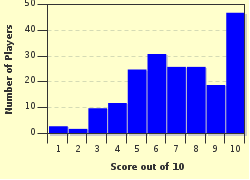Quiz Answer Key and Fun Facts
1. The Mariana Trench is deeper than Mount Everest is high.
2. The Mariana Trench was created through a process known as subduction, which occurs when ___.
3. The deepest part of the Mariana Trench, with a depth of 11,033 meters, is known as what?
4. What was the name of the first manned submersible to travel to the bottom of the trench?
5. The closest island to the Mariana Trench is Fais Island, a tiny land mass that's part of the State of Yap (a member state of the Federated States of Micronesia). The second closest is a historically significant US territory. Which one?
6. The Mariana Trench is the closest place to the center of Earth.
7. The Mariana Trench is home to a surprisingly large variety of life forms. Among these is a horrifyingly ugly fish that dangles a bioluminescent fleshy bulb in front of its head to lure prey. What fish is this?
8. As the ocean's crust slopes into the Mariana Trench and eventually into the mantle, some of the crust melts and floats out of the trench, where it cools around a chain of underwater volcanoes. These volcanoes are part of a larger chain of volcanoes that stretch all around the Pacific. What is this chain nicknamed?
9. Hydrothermal vents are a common sight on the floor of the Mariana Trench and are the energy source for many bacteria. What noxious fume do many of them release?
10. Why was the bottom of the Mariana Trench considered as a possible site to dump nuclear waste?
Source: Author
redsoxfan325
This quiz was reviewed by FunTrivia editor
gtho4 before going online.
Any errors found in FunTrivia content are routinely corrected through our feedback system.


